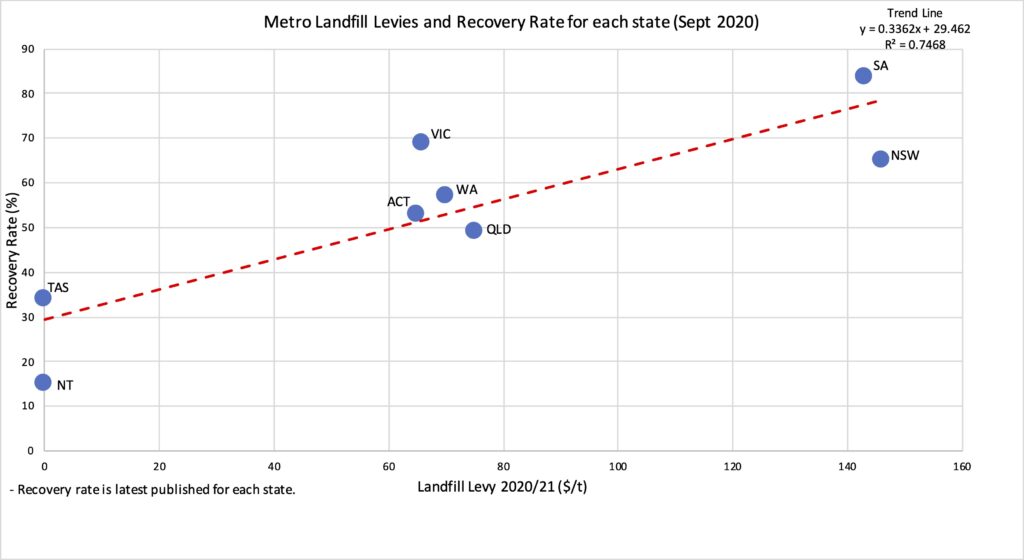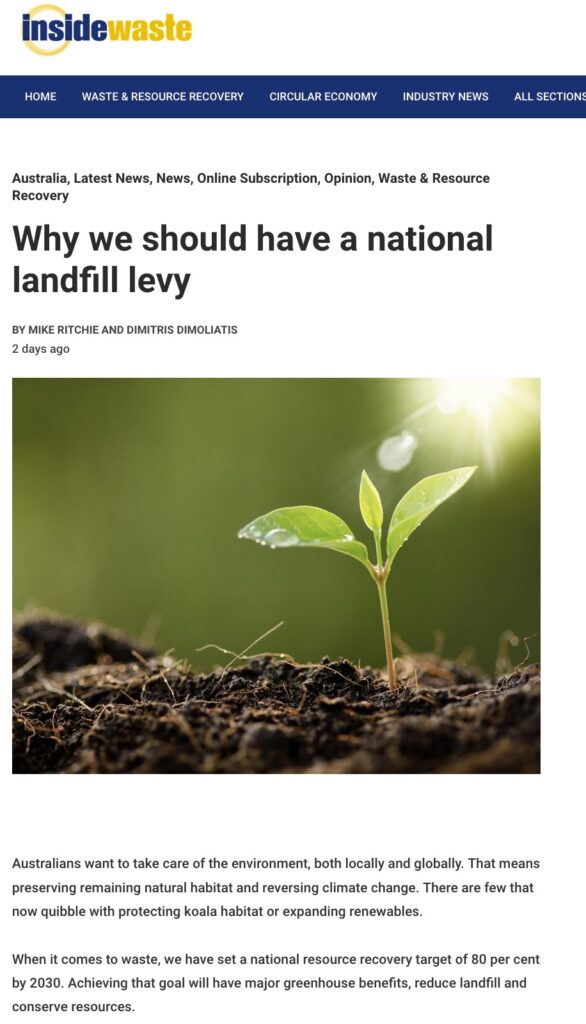Why we should have a national landfill levy
By: Mike Ritchie and Dimitris Dimoliatis, MRA Consulting Group

Australians want to take care of the environment, both locally and globally. That means preserving remaining natural habitat and reversing climate change. There are few that now quibble with protecting koala habitat or expanding renewables.
When it comes to waste, we have set a national resource recovery target of 80% by 2030. Achieving that goal will have major greenhouse benefits, reduce landfill and conserve resources.
Our destination is set. We have made a decision on where we want to go. But we are missing the crucial analysis of how to get there. What actions? What tactics? How to win the politics?
In the 5th century B.C., Sun Tzu said “Strategy without tactics is the slowest route to victory. Tactics without strategy is the noise before defeat.”
As things stand at the moment, we will not meet our 80% target. We simply do not have the necessary plans in place to achieve our strategic goal.
To reach our 80% target we need to build at least $5b of new infrastructure including sorting, processing and composting facilities. We need to grow our recycling rate from 34MT currently by another 12MT in only 9 years.
We need to maximise source separation by generators of waste and most crucially we need to focus on the big waste streams first.
As we have said many times it is the prerogative of Governments to set the targets but, once they have, they need to establish the markets and system dynamics to allow those targets to be achieved by industry, communities and stakeholders. Those markets and systems do not currently exist at enough scale.
How will we get $5b in infrastructure (large and small processing, composting, EfW etc) in only 9 years?
The simplest solution is to provide the incentives for the market to do it for us. That means getting the price signals right for companies to invest profitably in achieving our common goals.
Tweet
Landfill levies have started us on the right trajectory after years of squabbling. They set the market conditions and have driven most of the uptake in recycling in the last 20 years. Certainly all of the big investments and infrastructure builds would not have happened without the emergence of market pricing for recycling, driven by the levies.
Recent work by MRA Consulting Group shows there is a clear link between landfill pricing and resource recovery. The graph below highlights the point.
[The R2[1] shows that landfill levies explain over 70% of the variability of the curve.]
Of course the relationship between levies and resource recovery would be even more pronounced if levies were applied consistently across each state, with common pricing and application to geography.

In fact our recycling rates have grown from 7% in 1996 to 56% in 2019 largely due to the rise in market based pricing via landfill levies. The levies have and continue to do the heavy lifting when it comes to growing recycling and investment in recycling systems.
Consistency across all States would also prevent interstate movement of waste which saw over a million tonnes per year travelling from Sydney to south east Queensland until the QLD government reintroduced a $70/t levy last year.
Market signals drive investment in infrastructure but also the small decisions that waste generators make. As we have said previously:
If a generator of waste has a binary decision to make “Do I landfill this or recycle it?” price makes a big difference. If it is cheaper to recycle it, they will. If it is cheaper to landfill it, they will.
Ask any waste contractor and they will tell you this is the fundamental law of waste management.
To get to 80% diversion from landfill, we need to make the answer to that question simple and ever present. Recycling must become the default option.
So if we could achieve nationwide landfill levies what price should they be set at? We believe we should follow Europe which has landfill levies of over $250/t. That is high enough to make recycling almost always viable and cheaper than landfill for almost all waste streams in almost all locations.
If we are serious about an 80% target we need to get serious about encouraging investment and new systems. Of course we could just regulate to require recycling but most Governments find that a step too far.
We are not so naïve to think we could get to $250/t any time soon. But a nationwide landfill levy (applied by the States) of say $200/t (approx. $50 on top of NSW and SA levies today) would:
- Send a clear signal to waste generators to source separate.
- Ditto, service providers to profitably invest in infrastructure.
- Create the necessary headroom for recyclers to enter the market profitably.
- Generate $4 billion in revenue for State Governments.
- Accelerate recycling infrastructure through grants, hypothecation etc.
- Allow Governments to reduce inefficient taxes including Payroll Tax and Stamp Duty.
- Be an efficient tax with positive secondary effects (reduced landfill) whereas Payroll Tax and Stamp Duty have significant Dead Weight Loss.
Of course, everyone hates paying tax but better we pay a progressive and efficient tax than regressive and inefficient ones. The levy cost will be passed through the economy to waste generators who can avoid the levy by recycling.
To the extent that the levy raises additional revenue then Governments should reduce other inefficient taxes accordingly (but they won’t I hear you say; that is part of the deal). As a case in point Tasmanian local governments have called on the State to introduce a levy with maximum hypothecation so that they can consistently and uniformly reform waste in that State.
We also say that the increases in the levy (above current) should be hypothecated 100% to local government and industry recycling development. Priority should be given to funding regional waste management first.
Tweet
Landfill levies have proven their capacity to drive recycling in Australia. Only a market price (or interventionist regulation) has the power to grow recycling by another 12MT in only 9 years.
The magnitude of the levy (and greater consistency across States) is key. We cannot wait for Tas and NT to catch up. (Their tonnes are small).
In the absence of Governments intervening more directly in the waste economy, Australia needs a nationwide levy firstly in all metro areas and progressively spreading to all jurisdictions. Any increases should be 100% hypothecated to local government and industry to drive recycling.
Only such an intervention will achieve the 80% national diversion target by 2030.
Mike Ritchie, is the Managing Director of and Dimitris Dimoliatis is a Principal Consultant at MRA Consulting Group.
[1] R2 is used to measure the strength of the causal relationship between two quantitative variables (X variable being the Levy rate, Y variable being the Recovery Rate). The closer the R2 value is to 1, the stronger the positive causal relationship between the Levy and Recovery Rate. Meaning that the data fits the regression model. The closer the R2 value is to 0, the weaker the causal relationship is between the Levy and Recovery Rate.
This article has been published by the following media outlets:




